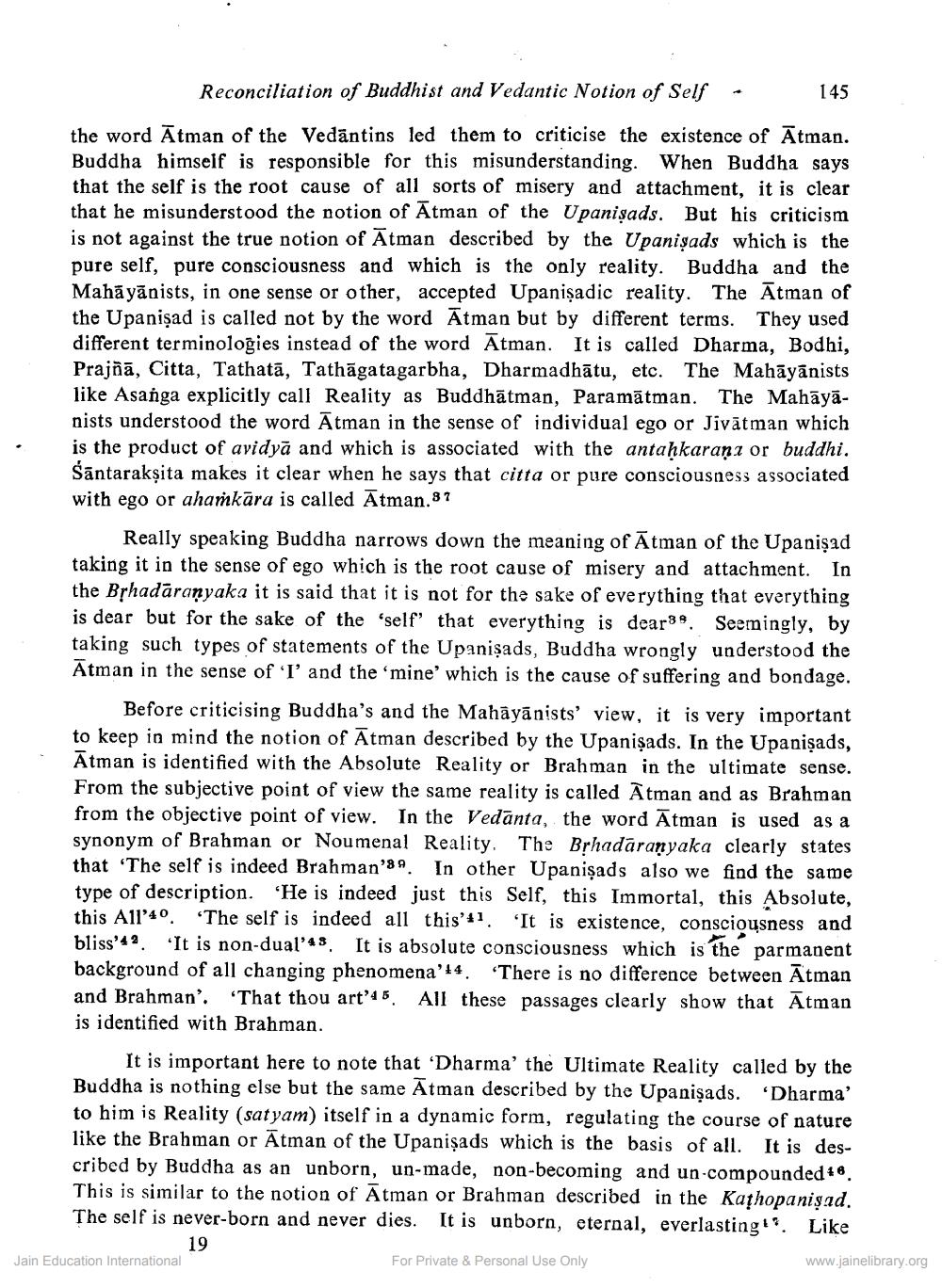Book Title: Reconcliation of Buddhist and Vedantic Notion of Self Author(s): Yajneshwar S Shastri Publisher: Z_Aspect_of_Jainology_Part_3_Pundit_Dalsukh_Malvaniya_012017.pdf View full book textPage 6
________________ Reconciliation of Buddhist and Vedantic Notion of Self the word Atman of the Vedantins led them to criticise the existence of Atman. Buddha himself is responsible for this misunderstanding. When Buddha says that the self is the root cause of all sorts of misery and attachment, it is clear that he misunderstood the notion of Atman of the Upanisads. But his criticism is not against the true notion of Atman described by the Upanisads which is the pure self, pure consciousness and which is the only reality. Buddha and the Mahāyānists, in one sense or other, accepted Upanisadic reality. The Atman of the Upanisad is called not by the word Atman but by different terms. They used different terminologies instead of the word Atman. It is called Dharma, Bodhi, Prajñā, Citta, Tathata, Tathāgatagarbha, Dharmadhātu, etc. The Mahāyānists like Asanga explicitly call Reality as Buddhātman, Paramātman. The Mahāyānists understood the word Atman in the sense of individual ego or Jivätman which is the product of avidya and which is associated with the antaḥkarana or buddhi. Santarakṣita makes it clear when he says that citta or pure consciousness associated with ego or ahamkara is called Atman.81 145 In Really speaking Buddha narrows down the meaning of Atman of the Upanisad taking it in the sense of ego which is the root cause of misery and attachment. the Brhadaranyaka it is said that it is not for the sake of everything that everything is dear but for the sake of the 'self' that everything is dear. Seemingly, by taking such types of statements of the Upanisads, Buddha wrongly understood the Atman in the sense of 'I' and the 'mine' which is the cause of suffering and bondage. Before criticising Buddha's and the Mahäyänists' view, it is very important to keep in mind the notion of Atman described by the Upanisads. In the Upanisads, Atman is identified with the Absolute Reality or Brahman in the ultimate sense. From the subjective point of view the same reality is called Atman and as Brahman from the objective point of view. In the Vedanta, the word Atman is used as a synonym of Brahman or Noumenal Reality. The Brhadaranyaka clearly states that 'The self is indeed Brahman's. In other Upanisads also we find the same type of description. He is indeed just this Self, this Immortal, this Absolute, this All40. The self is indeed all this', 'It is existence, consciousness and bliss'49. It is non-dual's. It is absolute consciousness which is the parmanent background of all changing phenomena'44. 'There is no difference between Atman and Brahman'. That thou art'45, 'That thou art'45. All these passages clearly show that Atman is identified with Brahman. It is important here to note that 'Dharma' the Ultimate Reality called by the Buddha is nothing else but the same Atman described by the Upanisads. 'Dharma' to him is Reality (satyam) itself in a dynamic form, regulating the course of nature like the Brahman or Atman of the Upanisads which is the basis of all. It is described by Buddha as an unborn, un-made, non-becoming and un-compounded 4. This is similar to the notion of Atman or Brahman described in the Kathopanisad, The self is never-born and never dies. It is unborn, eternal, everlasting. Like 19 Jain Education International For Private & Personal Use Only www.jainelibrary.orgPage Navigation
1 ... 4 5 6 7 8 9 10 11 12 13 14
